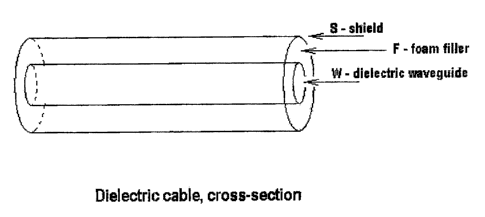Note : Les descriptions sont présentées dans la langue officielle dans laquelle elles ont été soumises.
CA 02449596 2003-12-05
Dielectric Cable System For Millimeter Microwave
DESCRIPTION
Introduction
Issue of the optimal method of transmitting energy from one place to another
with
the highest possible efficiency and the lowest possible losses is encountered
in
every area of engineering in practically every application dealing with
electrical,
electromagnetic or acoustic forms of energy. Such optimal solutions are very
different at each of the spectral range. At low frequency of electromagnetic
energy, when it is referred to as electrical energy we transmit power through
electrical cables consisting of two isolated conductors (single phase AC, or
DC)
or more conductors (3 or more phase AC). In the domain of high frequency
signals, typically 1 OOkHz-1 GHz the optimal choice of a cable is coaxial
cable
consisting of a center conductor surrounded by a dielectric insulator and
surrounded by a conductive shield, or a twisted pair cable similar to the one
for
low frequency AC power but with controlled impedance and low-loss dielectric
insulation. Beyond about SGHz up to about 30GHz the optimal, the least lossy
and most convenient way of transmitting microwave energy are metalic
waveguides. Beyond 30GHz however, metallic waveguides are becomming
increasing lossy which makes it difficult to transmit microwave power over
large
distances. At those frequency, in the so-called millimeter microwave range
such
waveguides are limited in practical applications to about couple of meters
distance due to high losses. From millimeter microwave up to the optical range
of electromagnetic energy, dielectric waveguidesloptic fibers become the most
optimal way of energy transmission.
Explanation of terms:
Waveguide: tubular circular or rectangular in cross section hollow structure
made
of conductive material (e.g. metal), that conducts electromagnetic energy
along
its length and inside it.
Dielectric Waveguide: tubular circular or rectangular in cross section solid
structure that conducts electromagnetic energy along its length inside and in
the
immediate vicinity outside of it.
Fiber Optic Cable: Dielectric Waveguide applied in the optical range.
"FiberGuide": dielectric waveguide in foam isolation that is used for
cinducting
millimeter microwave energy; the subject of this patent.
Coupler: mechanical device that allows joining two waveguides (dielctric
waveguide to dielectric waveguide or dielectric waveguide to metal waveguide)
together such that the energy transmission is unhidered.
CA 02449596 2003-12-05
EMBODIMENT OF THE INVENTION
In this embodiment, designed to transmit millimeter microwave at 70-90GHz,
dielectric waveguide consists of a polipropylene or PTFE cable/wire with
diameter of about 2mm (see FIG.1 ) surrounded by air filled foam that has a
very
low dielectric constant, and made out of material of very low dielectric
losses at
those frequency. The material of choice is polypropylene or PTFE. The whole
structure is surrounded by a metallic or metallized (from the inside} shield
or a
sleeve. A material of choice would be silver or aluminum coated polyester
foils
underneath PVC jacket, or copper foil underneath a PVC or PTFE jacket .
An alternative cross section (to circular) for the center waveguide is
rectangular
with approx 2:1 aspect ratio, to allow retaining the definite polarization
plane of
the transmitted wave.
Coupler for joining two dielectric cables together.
The couple consists of a plastic pipe a few cm long, threaded inside from both
ends, see FIG.2. Inner diameter of the pipe is a fraction of millimeter
smaller
than the outer diameter of the Dielectric Cable outer sleeve. One end is
threaded with a right-hand-side thread, the other left-hand side such, that
when
the dielectric cable is pushed from both end, both ends of the cables may be
screwed in simultaneously by turning the pipe, until both open sections of the
cables will meet in the middle. Since the millemeter microwave fit is tolerant
to
within quarter-wavelength, that is about 1 mm in this case, the fit need not
be as
tight and precise as in case of optical fiber junction. In this particular
example a
0.5 or even 1 mm gap may be tolerable.
RESULTS OF PROTOTYPE TESTING
[To be included]
Conclusions:
The laboratory tests prove the concept and demonstrate that it works
2
